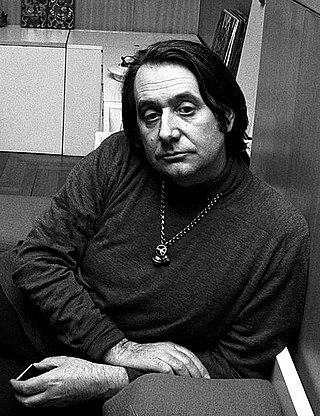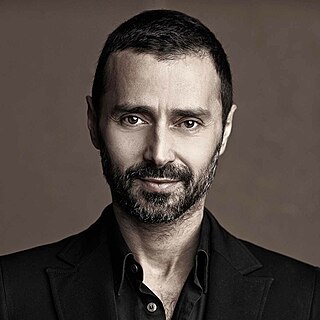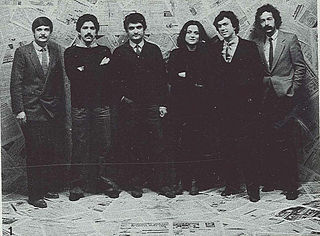
Ettore Sottsass was a 20th century Italian architect, noted for also designing furniture, jewellery, glass, lighting, home and office wares, as well as numerous buildings and interiors — often defined by bold colours.
Superstudio was an architectural firm, founded in 1966 in Florence, Italy by Adolfo Natalini and Cristiano Toraldo di Francia, later joined by Gian Piero Frassinelli, Alessandro and Roberto Magris, Alessandro Poli.

Piero Fornasetti was an Italian artist and designer.

The House for an Art Lover is an arts and cultural centre in Glasgow, Scotland. The building was constructed between 1989 and 1996 based on a 1901 Art Nouveau house design by Charles Rennie Mackintosh and his wife, Margaret MacDonald. The house is situated in Glasgow's Bellahouston Park and sits east of the site of the Festival Tower of the Empire Exhibition, Scotland of 1938.

Ben van Berkel is a Dutch architect; founder and principal architect of the architectural practice UNStudio. With his studio he designed, among others, the Erasmus Bridge in Rotterdam, the Moebius House in the Netherlands, the Mercedes-Benz Museum in Stuttgart, Germany, Arnhem Central Station, the Singapore University of Architecture and Design, Raffles City in Hangzhou and numerous other buildings.
Superarchitettura is a theoretical & conceptual framework, whose physical definition has been given at the homonymous 1966 exhibition, held at Jolly2, an art gallery of Pistoia, Italy.

Arturo Dell'Acqua Bellavitis is the current director of the Milan Triennale Foundation and Exposition.
Andreas Vogler is a Swiss architect, designer and artist. He is founder and director of the architecture and design firm, Andreas Vogler Studio.

Fabio Novembre is an Italian architect and designer.

STUDIODADA was an Italian architectural and design office which started in 1977 during Italy's radical period. It completed interior design and architecture projects in Italy and abroad. It ceased to operate in 1988.

The Memphis Group, also known as Memphis Milano, was an Italian design and architecture group founded by Ettore Sottsass. It was active from 1980 to 1987. The group designed postmodern furniture, lighting, fabrics, carpets, ceramics, glass and metal objects.

Aldo Cibic is an Italian designer.
Antonio Pio Saracino is an Italian architect, sculptor, and designer based in New York City. He has designed monuments, buildings, and modern furniture, and several of his designs are part of the permanent collections of museums such the Brooklyn Museum, the Museum of Art and Design in New York City and the Powerhouse Museum in Sydney. Saracino's work has been shown in international exhibitions and received reviews in publications such as The New York Times and Architectural Digest. His statues The Guardians: Hero and Superhero are in Bryant Park in Manhattan. Vogue named him "among the most prolific Italian designers abroad."

Afra and Tobia Scarpa are award winning postmodern Italian architects and designers. Their pieces can be found in museums across the United States and Europe, including collections in MoMA and the Louvre Museum. They have collaborated with companies such as B&B Italia, San Lorenzo Silver, and Knoll International. They have won a number of awards such as the Compasso d'Oro in 1969 to the International Forum Design in 1992. Their design work consists of architecture and everyday household items including, furniture, clothing, interior design, art glass. They focused on the technical and aesthetic possibilities of materials in their designs. The couple was greatly influenced by Tobia’s father, Carlo Scarpa, a Venetian architect and designer.
Paola Navone is an Italian architect and designer. She was born in Turin, Italy.
Roberto Gargiani is an Italian architectural historian and a full professor at the École Polytechnique Fédérale de Lausanne (EPFL).

Andrea Branzi is an Italian architect, designer, and academic. He was born and raised in Florence, though he lived and worked in Milan for much of his career. He was a professor and chairman of the School of Interior Design at the Polytechnic University of Milan until 2009.
Tomoiku Ara is a Japanese architect and interior designer. He graduated from the Nihon University Department of Fine Arts.
UFO was a design and architectural group founded in Florence, Italy, active between 1967 - 1978. A major part of the Radical architecture and design movement of the late 1960s, they studied under Umberto Eco at the University of Florence. Fellow alumni included the founders of Superstudio and Archizoom Associati.
Martine Bedin is a French architect and designer. She was a member of the Memphis Group.











